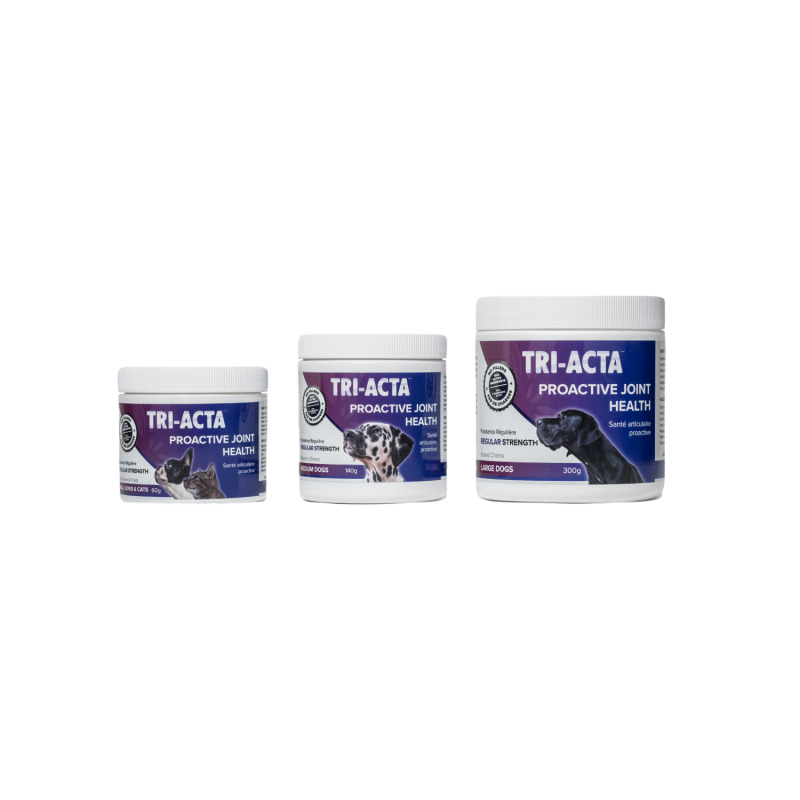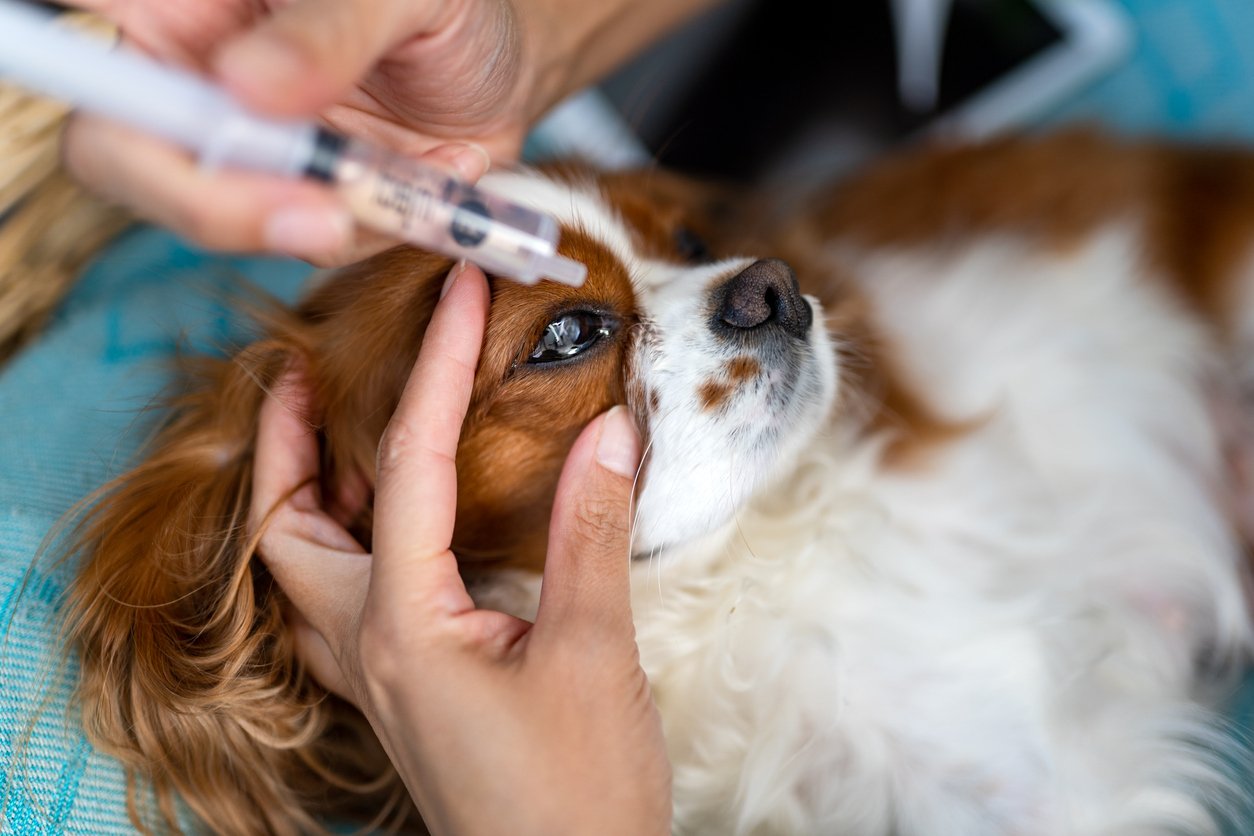Table of Contents
Your dog’s nose might be one of the most powerful parts of their body in terms of helping them understand the world around them, but their eyes are important as well. While human eyes have three different types of cones, which allow us to see combinations of red, blue, and green, dog eyes only have two types of cones, meaning they can only see blue and yellow. As a result, dogs are red-green color blind.
In addition, dogs typically have 20/7 vision, which means they can see about 20 feet (a little over 6 meters) in front of them. Certain breeds of dogs may have better vision, like Labradors, which are usually bred for better eyesight and tend to have vision that is closer to 20/20, like humans.
Even though dogs primarily use their noses to understand the world around them, their eyes help them with essential things like depth and peripheral perception. This helps dogs effectively navigate the world around them, like finding their owner in a sea of people at the airport:
As you can imagine, a dog eye infection can significantly impact your dog’s overall coordination, especially if the infection results in them not being able to see well. Worse still, without effective treatment, a dog eye infection could potentially result in permanent damage to your dog’s eye, or the infection spreading to other parts of your pup’s body.
Recognizing the signs and symptoms of a dog eye infection is essential so that you can give your pup prompt treatment, as the infection can progress rapidly.
In this article, we explore common causes of eye infection in dogs, symptoms of eye infection in dogs that you should look for, and options for at-home treatment.
How Do Dogs Get an Eye Infection?
There are a wide range of ways that an eye infection in dogs can occur. Sometimes our furry best friends can get into something they shouldn’t have, like a bag of garbage, and get an infection from foreign material entering the eye and causing damage as they blink and move their eyes around. Other times, the cause of a dog eye infection can be less straightforward and be a result of another health issue a dog can experience like allergies or a virus.
Causes of a Dog Eye Infection
There are two main causes of an eye infection in dogs, viral and bacterial. While bacterial infection is more common, viruses can affect the eye in such a way that makes it a perfect environment for bacteria to grow and cause an infection.
- Viruses (distemper, herpes, hepatitis, or canine influenza) are infectious agents made of protein and nucleic acid and cause trauma to the eye or cause the eye to dry out, which results in a breakdown of the eye’s built-in defenses against bacteria. As a result, bacteria is able to grow freely in the eye.
- Bacterial infection can be the secondary result of a viral infection as explained previously, or it can be caused by an injury, such as a scratch or ulcer on the eye. Usually, a bacterial infection is caused by a series of events, like a dog scratching their eye during rough play and then the dirt from the nails entering the eye, which then gets infected. The bacteria present in the eye will prevent it from healing until it’s cleaned out. The wound may not be visible to you, but your dog will squint and blink from the pain.
Types of Dog Eye Infection

The four common types of eye infections in dogs are outlined in the table below:
|
Dog Eye Infection Type |
Description |
|
Conjunctivitis (pink eye) |
The mucous membrane of the eye that covers the outer portion of the dog’s eyeball and the inside of the eyelid gets inflamed. |
|
Keratitis (inflammation of the cornea) |
The cornea is the transparent dome that covers the dog’s pupil, iris, and anterior chamber. Keratitis can affect the dog’s vision. |
|
Tear gland issues/physical eye abnormalities |
Some physical eye abnormalities that can cause tear gland issues in dogs, which can lead to a dog eye infection, include:
|
|
Uveitis |
Inflammation of one or more inner structures of the eye, such as the iris, ciliary body (the area between the lens and the iris at the periphery of the eye), or choroid (middle layer of the eyeball that contains blood vessels). |
Signs of Eye Infection in Dogs
Signs are visual indications that your dog is experiencing a health issue that needs attention. Common signs of eye infection in dogs that a pup would typically show include:
- Redness of the eye itself or the surrounding tissues
- Swelling of the tissues around the eye
- Eye swollen shut
- Watery discharge or tearing
- Thick, smelly green dog eye infection discharge (can also be yellow or white)
- General changes in the appearance of the eye itself (e.g., discoloration or bulging)
Although there are many physical signs to look for, sometimes spotting a dog eye infection can be tough, because your dog’s eye might look fine. In these cases, you’ll likely notice behavioral changes in your pup, like them acting more irritable and aggressive than usual. It’s important to take note of behavioral changes as they could be an indication that something is wrong with your pup, even if you can’t see anything physically different.
Dog Eye Infection Symptoms
Identifying dog eye infection symptoms can be tricky since your pup can’t exactly tell you in English that they are in pain or uncomfortable. Unlike signs, symptoms are experienced by your dog and can be undetectable visually, like pain. But since our pups can’t tell us if they are experiencing pain, we must rely on behavioral observation and other “tells” that something may be wrong with our dogs. Some symptoms can be measured as well if we have the foresight to check them, such as temperature.
Some common symptoms of eye infection in dogs that your pup may exhibit include:
- Pawing, rubbing, or scratching at the affected eye
- Excessive squinting or blinking
- Holding eye closed
- Sensitivity to light (squinting when looking at lights, turning head away suddenly from a light source)
- Increased irritable behavior or aggression
Dog Eye Allergies vs Infection
It’s easy to confuse allergies with an eye infection because some of the signs of eye infection in dogs that your pup will show will be the same or similar.
For instance, your dog will likely have itchy and irritated eyes with allergies and infection, and paw or scratch at them to relieve the itching, which aggravates the eyes and causes them to become red and swollen. They will also likely squint or excessively blink with both a dog eye infection and allergies.
Thankfully, there are some ways that you can narrow down whether your dog has an eye infection or is experiencing allergies, as outlined in the table below:
|
Dog Eye Infection |
Allergies |
| Cloudy, yellowish, or green discharge, especially if it’s thick May not have a specific event that can be linked to the eye issues (e.g., being outside, trauma to the eye, etc.) |
Clear and watery discharge Signs and symptoms (itching, irritation, behavioral problems) only show after a specific event, like being outside in the grass or eating a certain food |
If your dog has combinations of different signs and symptoms, it can be easier to identify whether it’s an infection or allergy. For example:
Sensitivity to light and clear, watery discharge tends to lean more towards an eye allergy rather than a dog eye infectionClear, watery discharge paired with significant swelling could indicate an eye infection
Yellowish or green thick discharge paired with swelling likely indicates a dog eye infection
Essentially, matching potential causes of your dog’s eye condition will help you narrow down whether they are more likely to be experiencing allergies or an infection. If your dog always gets itchy, watery eyes after they’ve been sniffing around outside in your garden packed with daisies (a daisy is a common flower that dogs can be allergic to or have a severe reaction to), then it’s likely that they are experiencing an allergy. On the other hand, if your pup has been inside all day and hasn’t come into contact with anything out of the ordinary and starts to develop eye issues, then it could be an infection.
Plus, repeated exposure to allergens can potentially result in a dog eye infection, as your pup may scratch and injure their eyes because they are itchy and uncomfortable, which can then become an infection in your dog’s eyes. In this way, allergies can indirectly result in a dog eye infection.
It’s important to note that even with the above ways to narrow down your dog’s condition, you can’t definitively diagnose your pup with either allergies or a dog eye infection. As with any potential medical issue that your dog may be experiencing, it’s important to take your dog to see a veterinarian so they can examine, diagnose, and treat your dog’s condition appropriately.
Not All Eye Problems in Dogs are Infectious
Some eye problems that dogs can get will masquerade as a dog eye infection because they display the same or similar signs but are not infectious. These conditions include:
- Glaucoma
- Tear duct problems or eye defects
- Dry eye
- Vitamin deficiency
- Exposure to or ingestion of toxins (e.g., smoke, ash, or liquid chemicals such as household cleaners)
- Cherry eye (prolapse of the third eyelid gland)
- Structural problems with the eye itself (e.g., entropion or ectropion)
While these doggy eye issues aren’t infections, they still cause pain and discomfort for your furry friend and need veterinary attention to correct or treat.
Treatments for Eye Infection in Dog
The most effective treatment for your dog’s eye infection will depend on the underlying cause and the location of the infection (e.g., eyelid or cornea). Typically, a combination of topical (cream), eye drops, and oral (pills) antibiotic medications will be prescribed to help your pup heal. Your veterinarian may also prescribe anti-inflammatory drugs to help relieve pain. With severe infection in dogs eyes, surgery may also be necessary.
Here are some common dog eye infection conditions and treatments prescribed for them:
- For a bacterial dog eye infection, antibiotics will usually be prescribed alongside eye drops to moisten and relieve pain and irritation. Also, eye drops are effective for getting medication into deeper structures of the eye to assist with healing.
- Any foreign bodies or debris in your dog’s eye will be removed by your veterinarian to prevent further infection. Anesthetic or sedation may be necessary in this case.
- Allergies may indirectly cause a dog eye infection, so your vet may need to treat the body’s response to the allergen by using antihistamine medication.
- Similar to allergies, if your dog has an underlying condition contributing to infections in their eyes, then a vet would need to identify and treat the underlying condition to prevent further infections. For instance, if your dog has a dry eye (which results in a prime breeding ground for bacteria), they will likely prescribe medications like cyclosporine or tacrolimus, which stimulate tear production. Your dog will likely need to take these medications for the rest of their life.
- Eyelid or eyelash abnormalities that cause the lashes to rub against the eyeball are generally treated with surgery. Dog breeds with droopy faces, like Basset Hounds, Bloodhounds, Pomeranians, and Chow Chows, often have eyelid issues, but any dog can potentially develop eyelid conditions.
Can You Treat a Dog With Eye Infection at Home?
A Dog eye infection can progress rapidly from a minor condition like slight eye irritation to something very serious like blindness, so it’s important to take your dog to the vet as soon as possible to get a definitive diagnosis. With that being said, there are some things that you can do at home to help your dog feel more comfortable.
1. Keep the Eye and the Surrounding Area Clean
Remove any buildup of discharge and dry, crusty remnants using a clean, soft, damp cloth, or use a pet care product like grooming wipes. Do not use chemicals like peroxide or makeup remover on your dog’s eyes, as these could aggravate the condition. Be gentle as you’re wiping. If there is debris you can’t seem to remove, leave it for your veterinarian, as they have specialized knowledge and tools to assist them with removal.
2. Use an Elizabethian Collar (Dog Cone) if You Have One
If you already have a cone at home, place it on your dog to prevent them from scratching and otherwise irritating the eyes further. Excess scratching and rubbing can easily turn a minor condition into a major one.
3. Use Only Plain Saline Eye Drops on Your Dog
Human eye drops can contain chemicals that could be harmful to your dog, but if you have a plain saline solution (sterile salt and water) at home, you can place that into an eye dropper to help clean out your dog’s eyes. There are even recipes online that you can follow to make saline solution at home.
How to Prevent an Infection in Dogs Eye
Recognizing the signs and symptoms of an eye infection in dogs and applying treatment is one thing, but prevention is the best medicine when it comes to dog eye infections. Here are some simple yet effective practices that you can action to keep your pup’s eyes happy and healthy:
Keep Your Dog’s Eyes Clean
If your dog has long hair, be sure to keep it trimmed around the eyes. This prevents long hairs from accidentally getting into their eyes and helps prevent eye gunk buildup. That being said, some breeds of dogs are notorious for getting brown stains on their fur from regular eye discharge. These brown stains are usually not a problem other than being not so nice to look at, but a buildup of discharge can become a prime breeding ground for bacteria, which can easily get into the eyes. Wiping any dry and crusty bits away with a clean, damp cloth is important to prevent nasty bacteria from entering your dog’s eye structures.
Treat Conditions or Illnesses Promptly
Some common conditions that dogs may get at some point in their life can affect their eyes. These conditions include:
- Hypothyroid disease can result in a lack of tear production and thus dry eye. Also called keratoconjunctivitis sicca (KCS).
- Tick-borne disease can also cause serious issues with dog eyes, including uveitis (inflammation) and hemorrhage in certain areas, but these ocular issues in dogs with this condition are thankfully relatively rare (only 10–15% of dogs infected with tick-borne disease will show eye issues).
- Infectious canine hepatitis can also cause eye issues in dogs, leading to infection. Signs include involuntary twitching and blinking (blepharospasm), constricted pupil (miosis), and light sensitivity (photophobia).
- Hypertension can result in hemorrhage of the delicate and small veins of the eye, leading to inflammation and retinal detachment.
- Metastatic neoplasia is essentially a tumor that forms in the eyes and causes a variety of issues like conjunctivitis, uveitis, hyphema (collection of blood in the lower eye), and retinal edema (swelling in a part of the retina), which can all lead to infection if not treated.
Some conditions that may seem minor, like pink eye, may actually be a secondary sign of another, more serious condition. This is why taking your dog to the vet is important if you notice any abnormal signs in their eyes.
Feed Your Dog Probiotics
Aside from being good for your dog’s overall gut health, there is some evidence that suggests adding probiotics to your dog’s diet can help reduce tear staining. This is important because excessive tears can lead to a buildup of crusty structures in your dog’s fur around their eyes, which can increase the chance of bacterial formation that can then travel into your dog’s eye structures.
Summary
Understanding the intricacies of your dog's vision and recognizing the signs of eye infections is crucial for their overall well-being. Even though dogs typically have limited vision (compared to humans), they still partly rely on their eyes for navigating the world.
When infections strike, they can swiftly impair the dog’s vision and quality of life. By being vigilant about your dog's eye health, seeking professional help when needed, and maintaining a proactive approach to your pup’s overall well-being, you can ensure that your best buddy continues to live a healthy and happy life.
Another common ailment that dogs often experience aside from eye infections is joint issues. Arthritis in dogs is extremely common, affecting as many as 20% of all dogs in North America. Giving your dog a joint supplement, even if they aren’t exhibiting any signs of joint pain, is important for preventing serious issues from developing down the road. TRI-ACTA is a joint supplement that contains two types of glucosamine for dogs, sulfate and HCl, alongside Methylsulfonylmethane (MSM, a natural anti-inflammatory) and chondroitin, to give your dog maximum joint protection and support.
If your dog needs a bit more oomph because they are already showing signs of joint issues, then TRI-ACTA H.A., which includes hyaluronic acid, is recommended. The hyaluronic acid helps increase the viscosity of the synovial fluid in your dog’s joints, allowing for easier and pain-free movement.
TRI-ACTA for Pets
A proactive approach for developing and younger adult pets to maintain optimal joint health mobility, minimize inflammation and fend off age-related ailments.

Purchase TRI-ACTA online or learn where to buy at a store near you.
Newsletter Signup
Subscribe to our newsletter to receive the latest news and exclusive offers.
.jpg?height=2000&name=Cliick_Integricare-DISPLAY-REVISEDV2%20(1).jpg)
Proactive & Therapeutic Joint Supplements
When given daily, Integricare joint supplements recover bone and joint injuries faster and help prevent mobility injuries from happening in the first place.










.jpg?width=488&height=325&name=dog-paw-infection%20(1).jpg)
